|
|
ARTHROPODS:
Insects»
Spiders»
Centipedes»
Millipedes»
Sowbugs»
Harvestmen»
Mites
& Ticks»
Scorpions»
Identification
Tips»
About
the Critter Files»
Links» |
|
|
|
 |
ASSASSIN
BUGS & AMBUSH BUGS
Critter
Files/Insects/True
Bugs/Assassin & Ambush Bugs
By Blake Newton
University of Kentucky Department of Entomology |
| |
|
| Common
Kentucky Assassin Bugs & Ambush Bugs: |
| |
| TAXONOMY |
KINGDOM:
Animalia | PHYLUM: Arthropoda | CLASS: Insecta | ORDER: Hemiptera
| FAMILY: Reduviidae (assassin bugs & ambush bugs) |
| |
| Other
Names: Reduviids |
| |
WHAT
IS AN ASSASSIN BUG?
LIFE CYCLE
ECOLOGY
PEST STATUS
COMMON KENTUCKY ASSASSIN & AMBUSH BUGS
COLLECTING & PHOTOGRAPHY
ASSASSIN BUG FACTS
MYTHS, LEGENDS, AND FOLKLORE |
| |
| WHAT
IS AN ASSASSIN BUG? |
|
Assassin
Bugs and Ambush Bugs are in the order
Hemiptera which also includes stinks
bugs, leaf-footed bugs,
and other insects. All insects in Hemiptera share a few characteristics,
including piercing and sucking mouthparts, and wings which are membranous
and clear at the tips, but hardened at the base.
Assassin bugs and ambush
bugs are in the family Reduviidae. Insects in this family
are distinguished from other members of Hemiptera by their short,
3-segmented beaks (most Hemiptera have 4-segmented beaks).
WHAT IS AN AMBUSH
BUG?
Technically, ambush bugs are a type of assassin bug, but there are
a few differences. Assassin bugs are usually dark-colored,
with combinations of gray, green, and black. Assassin bugs
also have long, narrow heads compared to ambush bugs. Ambush
bugs are usually stoutly built and typically have bright colors:
yellow, red, or orange. Ambush bugs have thickened front legs
which are used to capture prey. Assassin bugs will also use
their front legs to capture prey, but their front legs are not as
thickened as those of ambush bugs. |
| |
| COMPARISON:
Assassin Bug vs. Ambush Bug |
|
 Assassin
Bug (R. Bessin 2000)
Assassin
Bug (R. Bessin 2000) |
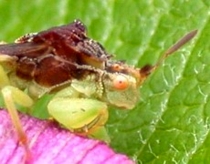 Ambush
Bug (B. Newton, 2004)
Ambush
Bug (B. Newton, 2004) |
|
|
| SIZE:
Assassin bugs up to 1 1/2", ambush bugs up to 1/2" |
| |
| LIFE
CYCLE |
|
Like
all members of the order Hemiptera, assassin bugs and ambush bugs
go through a simple metamorphosis with egg, nymph, and adult stages.
In warm months, females lay eggs which are stuck in clusters
to leaves and stems. After hatching, the wingless nymphs grow
and molt 4 times (some species molt 7 times) before becoming full-sized,
winged adults. Adults are usually the overwintering stage. |
| |

Wheel Bug Nymph (R. Bessin, 2000) |

Assassin bug nymph, Zelus sp.
(B. Newton, 2004) |
| |
| ECOLOGY |
|
|
Most members of the family
Reduviidae are predators. The nymphs and adults capture insects
and other arthropods in their raptoral (prey-grabbing) front legs,
then use their sharp beaks to suck fluids from their victim. They
also inject a small amount of poison that paralyzes their prey, making
it easier to handle. Assassin bugs actively hunt for prey, but
ambush bugs wait motionless for prey to come to them.
|
 Wheel
Bug feeding on a caterpillar
Wheel
Bug feeding on a caterpillar
(Image courtesy USDA Photo Set) |
| |
In general,
assassin bugs hunt on various types of vegetation, including trees,
weeds, and bushes. Ambush bugs usually hunt on flowers. Assassin
and ambush bugs are able to fly, but they are poor fliers.
Although assassin bugs
and ambush bugs are fierce predators, they are sometimes eaten by
birds, rodents, and large predatory arthropods, such as spiders,
praying mantids, and even other assassin and ambush bugs. Assassin
bug and ambush bugs are especially vulnerable to predation when
they are in the nymph stage.
PARASITIC REDUVIIDS:
A few species in this family are parasites that feed on the blood
of mammals. The Bloodsucking Conenose, Triatoma sanguisuga,
is a common example. It normally feeds on rodents, but will
sometimes bite humans that sleep near rodent nests. |
| |
| PEST
STATUS |
|
Bugs in
the family Reduviidae are considered pests when they bite humans.
Common predatory assassin bugs, like the Wheel Bug, will occasionally
inflict painful bites. For the most part, however, assassin
and ambush bugs have reputations as beneficial insects because they
feed on other arthropods.
Only the parasitic reduviids,
such as the conenose bugs, are true pests. Their bites sometimes
cause severe allergic reactions. However, they are not frequently
encountered in Kentucky. Read more about conenose bugs and
other biting bugs at this Texas A&M Extension website:
http://citybugs.tamu.edu/FastSheets/Ent-1018.html
|
| |
| |
| COMMON
KENTUCKY ASSASSIN & AMBUSH BUGS |
|
|
WHEEL
BUG
GENUS and SPECIES:
Arilus cristatus
The most commonly seen
assassin bug in Kentucky is probably the Wheel Bug,
Arilus cristatus, pictured below. At 1 1/2",
this silver-gray insect is the largest assassin bug that lives in
Kentucky. It gets its name from the structure on its thorax
which resembles a gear or saw blade. The wheel bug is notorious
for its painful bite, but it only bites on accident or if handled
carelessly. The nymph of the wheel bug is pictured above. |
| |
 Wheel
Bug (R. Bessin, 2000)
Wheel
Bug (R. Bessin, 2000) |
|
|
|
SPINED
ASSASSIN BUG
GENUS and SPECIES:
Sinea diadema
Sinea diadema,
pictured below, is usually called the Spined Assassin Bug.
It is often found on goldenrod and other wildflowers. Because
it is smaller than the wheel bug (at about 3/4") it is not
noticed as often, but the spined assassin bug is just as common,
if not more so. |
| |
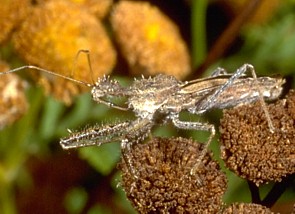 Spined
Assassin Bug (R. Bessin, 2000)
Spined
Assassin Bug (R. Bessin, 2000) |
|
|
|
BEE
ASSASSIN
GENUS:
Apiomerus crassipes
As
its name suggests, the Bee Assassin, Apiomerus
crassipes, is well-known for feeding on bees. Bee assassins
are good fliers, and will patrol flowering plants that are visited
by bees, flies, and other pollinating insects. Bee assassins
are usually dark in color with yellow or red markings on the sides
of the abdomen, and are about 3/4" long. The one below
was photographed in Rowan County. |
| |
 Bee
Assassin, Apiomerus crassipes (B. Newton, 2004)
Bee
Assassin, Apiomerus crassipes (B. Newton, 2004) |
|
|
|
ZELUS
spp.
GENUS:
Zelus
Pictured below is an assassin
bug in the Zelus genus, probably Z. exsanguis or
Z. luridus. These assassin bugs are commonly found
in trees and shrubs. They are about 3/4" long and have
bright green bodies with dark highlights. A Zelus nymph
is pictured above. |
| |
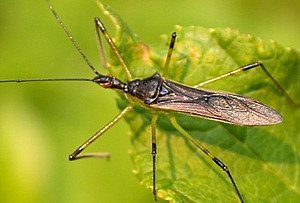 Zelus
sp. (B. Newton, 2002)
Zelus
sp. (B. Newton, 2002) |
|
|
|
PSELLIOPUS
spp.
GENUS:
Pselliopus
Common assassin bugs in
the Pselliopus genus are distinguished by
their black-banded, bright orange bodies. Adults are apx 1"
long. |
| |
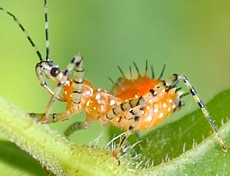 Pselliopus
sp. nymph
(B. Newton, 2004)
Pselliopus
sp. nymph
(B. Newton, 2004) |
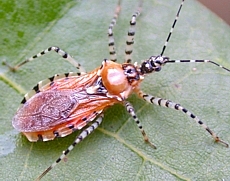 Pselliopus
sp. adult (B. Newton, 2005)
Pselliopus
sp. adult (B. Newton, 2005) |
|
|
|
CORSAIR
GENUS: Melanolestes
Corsairs are unusual assassin
bugs in the Melanolestes genus. Male corsairs have
full-sized wings and are sometimes found hunting on leaves and flowers.
Female corsairs, like the one pictured below, have stunted,
non-functional wings. They hunt under rocks, logs, and fallen
leaves for ground-dwelling prey like caterpillars, crickets, and
earthworms. Corsairs are about 1" long. Visit this
page at BugGuide.net for a picture of winged male corsair:
http://bugguide.net/node/view/7334/bgimage |
| |
 Female
corsair, Melanolestes sp. (B. Newton, 2004)
Female
corsair, Melanolestes sp. (B. Newton, 2004) |
|
|
|
AMBUSH
BUGS
GENUS:
Phymata
Ambush
Bugs, like
the one below, look different from other bugs in the Reduviidae family.
In fact, some scientists place ambush bugs in their own family,
Phymatidae. Ambush bugs are short and stout compared to assassin
bugs, and their front legs are thicker and shaped like praying-mantis
legs. Ambush bugs are commonly found on a variety of wildflowers
where they wait in ambush for bees, flies, and other prey. |
| |
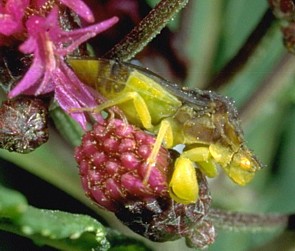 Ambush
Bug in the Phymata genus (R, Bessin, 2000)
Ambush
Bug in the Phymata genus (R, Bessin, 2000) |
|
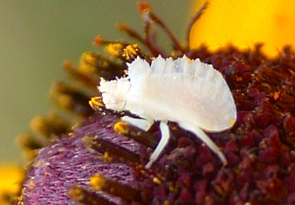 Ambush
Bug nymph (B. Newton, 2005)
Ambush
Bug nymph (B. Newton, 2005) |
|
| |
| COLLECTING
& PHOTOGRAPHY |
|
Assassin bugs and ambush
bugs are always an interesting addition to an insect collection.
Look for assassin bugs in any weedy or bushy area during warm
months, especially in hedge rows, along roadsides and fence rows,
in gardens, or along trails. Ambush bugs are commonly found
on wildflowers during the summer, but they are especially common
on goldenrod in late summer and early fall. Most assassin
bugs and ambush bugs are slow moving: if you find them, they are
usually easy to catch. They will also usually stay still for
a photograph. If you are patient, you may be able to snap
a picture of one as it slowly consumes its prey. Although
assassin bugs and ambush bugs are not considered dangerous, most
can bite, and should not be handled.
Assassin bugs can also
make great pets, and usually do well in captivity, although most
species only live for a year or two (and they can't be handled!).
For more information about keeping pet assassin bugs, visit
our Pet Bugs page: Assassin
Bugs.
|
| |
| ASSASSIN
BUG FACTS |
|
Because assassin bugs
are such good predators, scientists are interested in using them
as natural control agents of crop pests. Read about an important
assassin bug predator from California:
http://www.ipm.ucdavis.edu/PMG/NE/assassin_bugs.html
|
| |
| MYTHS
- LEGENDS - FOLKLORE |
|
Do you know any myths,
legends, or folklore about assassin bugs or ambush bugs? Let
us know if you do!
|
Original document: 25 May 2004
Last updated: 19Oct 2006
Photos courtesy R.
Bessin and B. Newton, University of Kentucky, except Wheel Bug Feeding
on Caterpillar, USDA Photo Set; used with permission.
The Kentucky Critter
Files are maintained by Blake Newton, Department of Entomology, University
of Kentucky.
Contact: blaken@uky.edu
|
|

